SEEDS: SOVIET JEWRY
Antisemitism was prevalent in tsarist Russia, causing many Jews to emigrate to escape religious and economic persecution. Others chose to fight on behalf of the 1917 Russian Revolution, believing that communism would end antisemitism. Instead, synagogues were shuttered and free religious practice was forbidden. Judaism was considered a “nationality.” Jews were denied entry into top schools and jobs.
Jews who applied to emigrate from the USSR were refused permission on the grounds they knew “state secrets.” Thus they became known as “refuseniks.” Many refusenik leaders were jailed as “Prisoners of Zion.” Not allowed to work, refuseniks were formally viewed by the Soviet establishment as parasites of the USSR.
Jewish communities have always supported Jews in need everywhere in the world. From the 1960s to the late 1980s, Jews united to fight for the emigration of Soviet Jews. Orlando’s Soviet Jewry committee formed in 1975. In the 1990s, $2.6 million was raised locally to resettle Jews in North America and Israel. The highest form of charity in Judaism is helping a person become self-reliant. This can be with a gift or loan or to enter into a partnership with her or him or to find employment until she or he no longer needs to be dependent upon others. Jewish Family Services caseworkers worked closely with the new Russian refugees to help them find good jobs
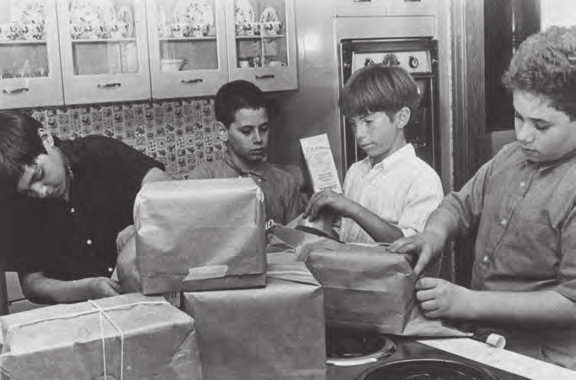 Young Judaea youth group members pack Passover matzah for fellow Jews trapped in the Soviet Union, 1968.
Young Judaea youth group members pack Passover matzah for fellow Jews trapped in the Soviet Union, 1968.
At Passover seders in Orlando and throughout the world, Jews recall the hasty Exodus of the ancient Hebrews from slavery in Egypt to freedom. For the week-long spring holiday, Jews eat unleavened bread called matzah, remembering that the Exodus from Egypt was so hurried that dough did not have time to rise. Because Jews in the Soviet Union were not permitted to obtain matzah under Communist rule, or any other religious items, Jews living in freedom sent matzah to them.
L-R: Steven Greenstein, Mark Schulman, Gary Goldberg and Mike Blaher
Collections of the Jewish Museum of Florida-FIU, originated by Marcia Jo Zerivitz, LHD, Founding Executive Director
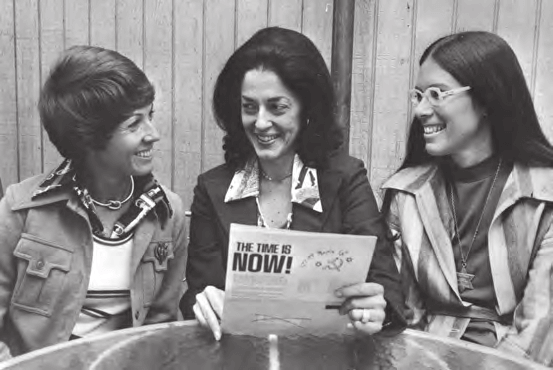 The time is NOW! Orlando rally urging freedom for Soviet Jews, 1975.
The time is NOW! Orlando rally urging freedom for Soviet Jews, 1975.
In August 1975, leaders of 35 countries including the USSR, signed the Helsinki Final Act, confirming international respect for national borders and urging peaceful dispute resolution. The Act also required respect for freedom of thought, conscience, religion and belief and recognized free movement of people and reunification of families as basic human rights. Though this was not a formal treaty, and thus was not legally enforceable, the document immediately became a powerful global tool to pressure the Soviet Union on human rights violations, including the right to leave. Orlando Jews joined others around the world in pressuring the Soviets to let their people go!
L-R: Marcia Kerstein [Zerivitz], chair of the Jewish Federation’s Community Relations Committee; Marlene Stone, wife of US Senator Richard Stone; and Eva London Ritt, chair and founder of the Committee to Free Soviet Jews
Collections of the Jewish Museum of Florida-FIU, originated by Marcia Jo Zerivitz, LHD, Founding Executive Director
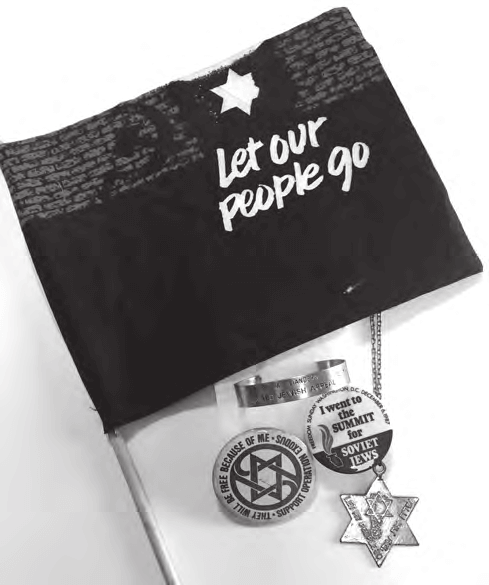
Jewelry worn in the US drew national attention to the plight of USSR Prisoners of Conscience and Refuseniks, 1975–1987.
Thousands of Soviet Jews were denied exit visas to Israel and many leaders of the movement were imprisoned (Prisoners of Conscience). In the US, buttons and engraved prisoner-of-conscience jewelry became popular, drawing attention to the Soviet Jewish plight. Many congregations “adopted” Soviet Jews, and tried to maintain contact with them. American Jews regularly petitioned government officials to take action. This 1975 necklace is engraved “Shlomo Drezner,” who was a member of the pro-Israel underground in Leningrad. Arrested in 1970 and sentenced to three years at a highsecurity camp, Dresner immigrated to Israel the year he was released.
Teresa Brickman Finer, Roz Ettinger Fuchs and Eva Ritt
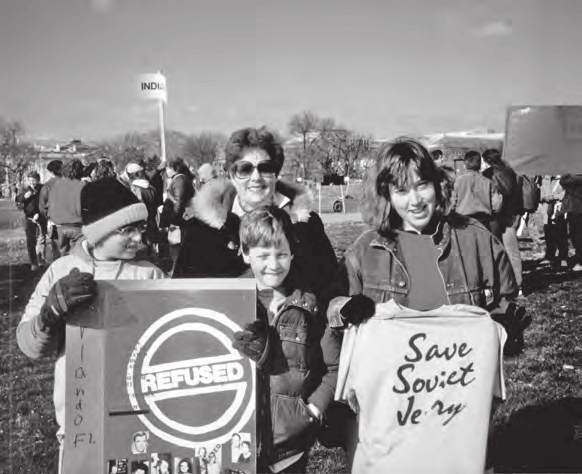
Among the 70 people from Orlando’s Jewish community who attended the famous March on Washington demanding freedom for Soviet refuseniks are L-R: David, Phyllis, Adam and Judith Zissman, December 6, 1987.
The morning before Russian Premier Gorbachev’s meeting with President Reagan, people converged to protest Soviet Jewish restrictions. One of the largest marches in US history, the rally mobilized American Jews behind a single cause, a turning point in the 40-year struggle for Soviet Jewish liberation. A shofar was blown, then Holocaust survivor Elie Wiesel and Russian dissident Anatoly (Natan) Sharansky, just released after nine years in Soviet prisons, spoke. The next day, Reagan told Gorbachev, “Yesterday I had 250,000 people in my backyard saying, ‘Let my people go.’ Until you do what they want, nothing will happen.”
Edward Zissman
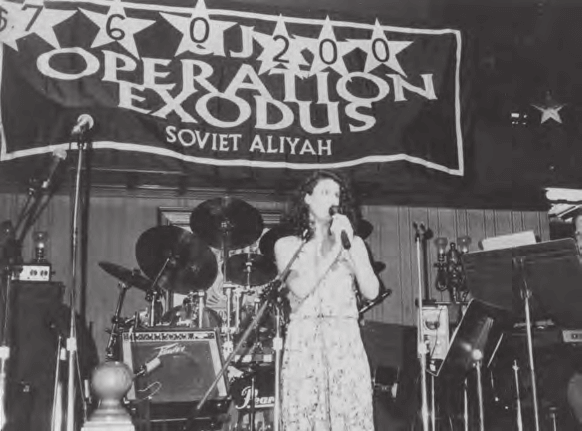 Kimberly Shader entertains a large crowd at Church Street Station for the Jewish Federation’s Operation Exodus event, organized to raise awareness about a modern-day Jewish exodus, 1990.
Kimberly Shader entertains a large crowd at Church Street Station for the Jewish Federation’s Operation Exodus event, organized to raise awareness about a modern-day Jewish exodus, 1990.
The international Operation Exodus campaign began in 1990 when Soviet President Mikhail Gorbachev relaxed restrictive emigration from the Soviet Union. The campaign, named for the biblical Exodus from Egypt, was first chaired by Hy Lake. David Albertson, Harold Kaplan and Charles Schwartz were also chairmen. Hundreds of Orlando residents made financial contributions and volunteered to help resettle families. Special mailings sent before Passover reminded families to remember the Soviet Jews as they commemorated the ancient Exodus from Egypt. During Operation Exodus, 700,000 Jews left the USSR for Israel and the US, including Central Florida.
Collections of the Jewish Museum of Florida-FIU, originated by Marcia Jo Zerivitz, LHD, Founding Executive Director
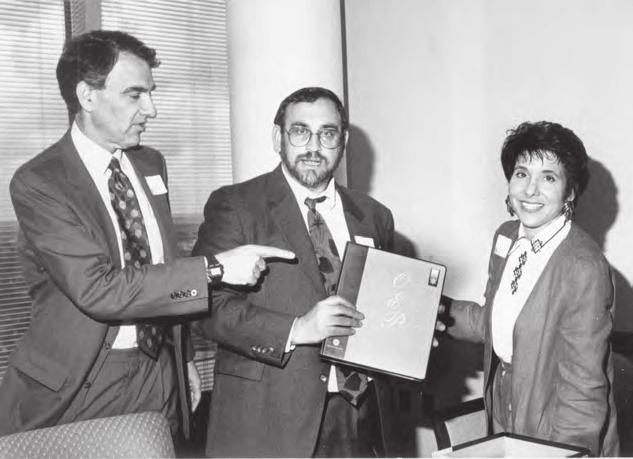 L-R: National vice chairman of Operation Exodus Shimon Pepper, along with and Barbara and Jim Grodin organized Flights for Freedom to fund Jewish refugees immigrating to Israel from Uzbekistan, 1995.
L-R: National vice chairman of Operation Exodus Shimon Pepper, along with and Barbara and Jim Grodin organized Flights for Freedom to fund Jewish refugees immigrating to Israel from Uzbekistan, 1995.
Barbara and Jim Grodin encouraged financial assistance to Jews leaving Uzbekistan by asking Orlando Jewish community members to fund seats on a plane. Orlando’s Flights to Freedom campaign raised enough money to pay for 900 seats—two full 747 airplanes. The Uzbekistani Jews were known as Isro’il or Yahudi, descendants of the Bukharan Jewish sect living in Central Asia since the 16th century. Bukharan were among the most isolated Jewish communities in the world. With the resurgence of Islamic fundamentalism, many felt the need to leave.
Jewish Federation of Greater Orlando
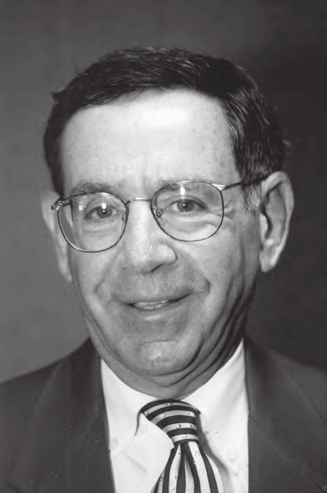
From 1990 to 1999, Gene Josephs chaired the Orlando Russian Resettlement Committee, c. 1980.
When the Orlando Jewish community learned that Orlando had been selected by the Hebrew Immigrant Aid Society to resettle more Soviet Jewish families, local businessman Gene Josephs led the effort. This included educating the community about the upcoming needs, recruiting committee volunteers from congregations and Jewish agencies and formulating budgets and policy. With professional support from Jewish Family Services, the Orlando Resettlement Committee greeted, housed and integrated 175 new immigrants. Families were given apartments, furniture and groceries for several months, and volunteers helped with English lessons, finding jobs and integrating children into their new world.
Gene Josephs
The Story of One Soviet Jewish Family.
On June 2, 1992, the Russian Resettlement Committee of Jewish Family Services (JFS) welcomed the Kimlat family from Ukraine. Volunteers greeted the family of five at the airport. For the first week, the family had dinner every night at the home of Michael and Debbie Kahn. When they moved into their new home, the Kimlats were overwhelmed by the furnished apartment and stocked refrigerator. Soon Boris and Irina found jobs with the help of JFS, and grandmother Inna daily practiced English. By September, she wrote, “Excuse me, my poor English. I and my family became new immigrants in America. I stride into unknowns and not at a young age. I hope that I can be useful to your society and I want to make friends among you.” Kostya Kimlat grew up to become a sleight-of-hand magician, motivational speaker and expert on the role of perception in life and business. In 2016, he married Amy Schwartz, marketing director of The Roth Family JCC. Older sister Jenya owns her own spa in Longwood, and is married with two children who participate at the JCC. After living in Orlando for 25 years, Boris Kimlat says, “The help of the community was so kind. We will always be grateful to Congregation Ohev Shalom, the leadership of Rabbi Aaron Rubinger and the constant support of then-president Mark Stone to help all of the families that were resettled. We are also grateful to Diane Brown from JFS. It is through the help of individuals and communities like Orlando that we can flourish as a Jewish family and live the American Dream.”
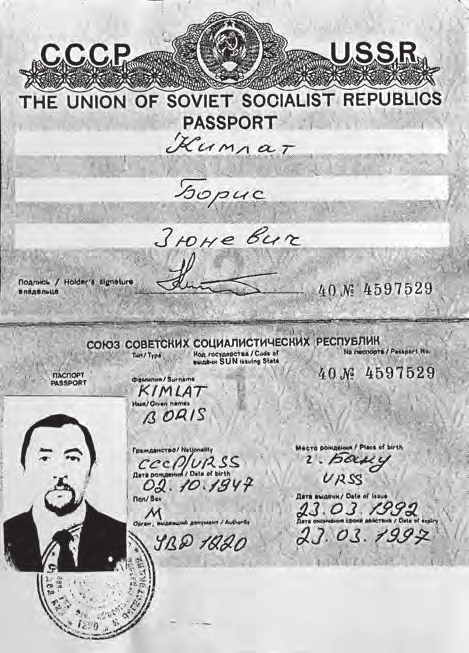
Boris Kimlat’s international Soviet passport that allowed him to travel from his native Ukraine, 1992.
When Kimlat requested this international passport so that he could leave the country, he was already carrying the internal passport required of all Soviet citizens. The internal passport identified the holder by full name, date, place of birth, social status and ethnicity. “Jew” was noted instead of “Russian” or “Ukrainian.” This “fifth paragraph” or the “fifth line,” as it was called, contributed to discrimination against Jewish citizens in higher education, top jobs, and international travel. The ethnicity line was finally dropped from Russian passports in 1997.
The Kimlat family
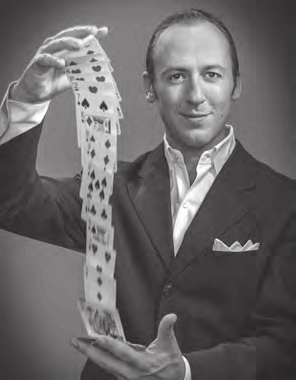 Kostya Kimlat lives in Orlando and lives a magical life, 2016.
Kostya Kimlat lives in Orlando and lives a magical life, 2016.
In August 2015, Kostya Kimlat bewildered the legendary magician duo Penn & Teller with an original card trick on their TV show, Penn & Teller: Fool Us.
The Kimlat Family
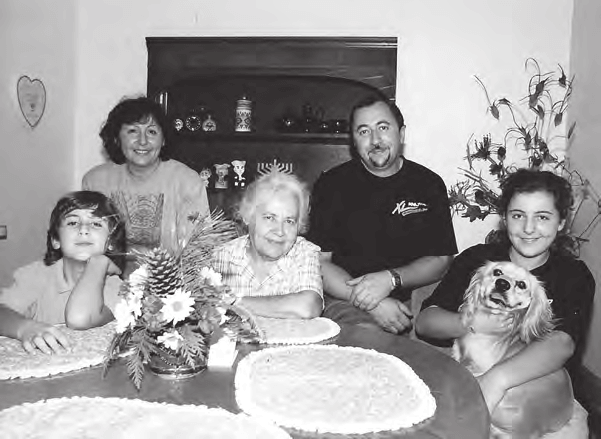
Kimlat family in their new Orlando home, September 1992.
L-R: Kostya Kimlat (age 10), Irina Khazina, Inna Shatsman, Boris Kimlat and Jenya Kimlat (age 15)
The Kimlat Family
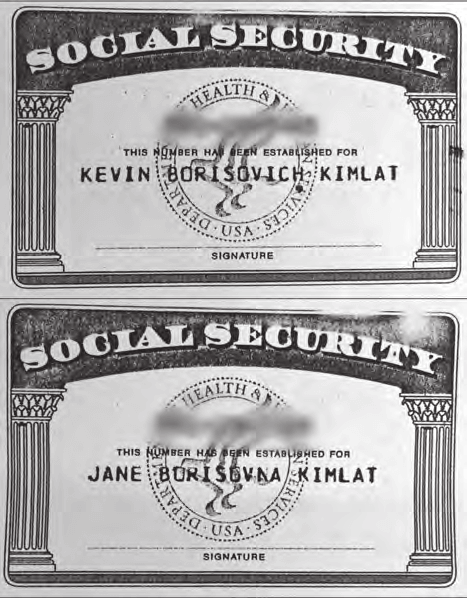
Trying to be like everyone else, the Kimlats request Americanized names on their new social security cards, 1992.
Jenya and Kostya became known as Jane and Kevin. Parents Boris and Irina were renamed Bob and Irene. Later the family realized they could be proud Americans while still maintaining their native culture, so they reverted to their original names.
The Kimlat Family
